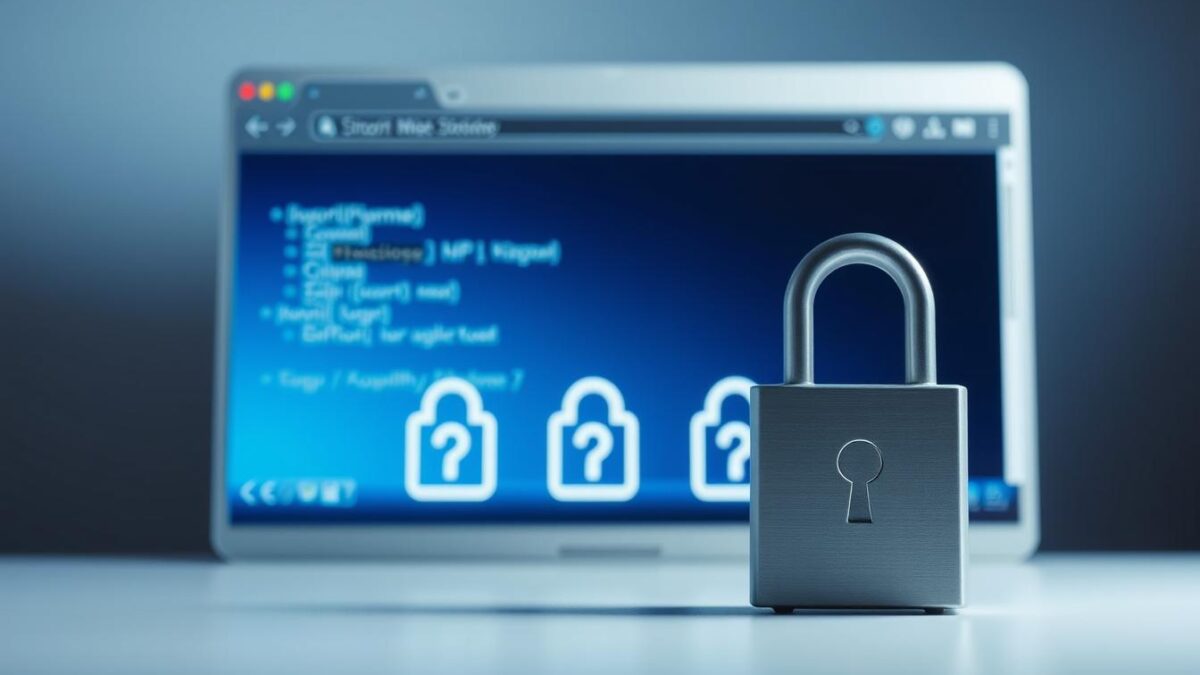
Secure Your Web Experience: Mastering Secure Browsing
In today’s digital age, securing your web experience is crucial to protect your personal information and online activities. Mastering secure browsing is essential to ensure that your online interactions are safe and private. This involves understanding the importance of internet security and taking proactive measures to protect your online presence through secure browsing and data protection.
To achieve a secure web experience, it’s essential to have a comprehensive guide that covers the essential components of a secure web experience and provides tips for implementing secure browsing practices. With the increasing number of online threats, it’s crucial to prioritize internet security and data protection to safeguard your online presence.
Introduction to Secure Browsing
By prioritizing secure browsing and internet security, you can protect your personal information and online activities from potential threats. This article will provide a comprehensive guide to secure browsing, covering the importance of online security, essential components of a secure web experience, and tips for implementing secure browsing practices to ensure data protection.
Key Takeaways
- Secure browsing is essential to protect your personal information and online activities.
- Internet security is crucial to safeguard your online presence.
- Data protection is a critical aspect of secure browsing.
- Implementing secure browsing practices can help prevent online threats.
- Prioritizing internet security can help protect your online presence.
Understanding the Importance of Secure Browsing
As we navigate the online world, it’s essential to prioritize our online privacy and security. A secure network is crucial for safe browsing, protecting us from various threats that can compromise our personal data. In today’s digital age, online security is no longer a luxury, but a necessity.
When we browse the internet, we leave behind a digital footprint, making us vulnerable to cyber attacks. To mitigate this risk, it’s vital to understand the importance of secure browsing. This includes being aware of current online security threats, such as malware and phishing, and taking proactive measures to protect ourselves.
Some key principles of online safety include using strong passwords, keeping software up-to-date, and being cautious when clicking on links or downloading attachments. By following these guidelines, we can significantly reduce the risk of our personal data being compromised. Additionally, using a secure network and practicing safe browsing habits can help protect us from online threats.
By prioritizing our online privacy and security, we can ensure a safe and secure browsing experience. This not only protects our personal data but also helps to prevent financial loss, identity theft, and reputational damage. By taking the necessary steps to secure our online activities, we can enjoy the benefits of the internet while minimizing the risks.
Essential Components of a Secure Web Experience
A secure web experience is built on several key components, including encrypted connections and secure web browsing practices. To ensure a safe online environment, it’s crucial to understand the importance of these elements and how they work together to protect your online activities.
Encrypted connections, such as HTTPS, play a vital role in securing your online communications. By using encrypted connections, you can prevent unauthorized access to your data and protect your online identity. Secure web browsing involves using a reputable web browser, keeping software up-to-date, and avoiding suspicious websites.
Some of the best practices for secure web browsing include:
- Using a reputable web browser that supports encrypted connections
- Keeping your operating system and browser software up-to-date
- Avoiding suspicious websites and links
- Using strong passwords and enabling two-factor authentication
By implementing these essential components and best practices, you can significantly reduce the risk of online threats and protect your online activities.
Remember, a secure web experience is not just about protecting your data, but also about ensuring that your online activities are private and secure. By prioritizing encrypted connections and secure web browsing, you can enjoy a safe and secure online experience.
How to Implement Secure Browsing Practices
To ensure a secure browsing experience, it’s essential to take a few simple steps. Secure browsing is crucial in today’s digital age, and by following these tips, you can significantly improve your browsing safety. When it comes to secure browsing, choosing a reputable browser is the first step.
A secure browser, such as Google Chrome or Mozilla Firefox, provides a solid foundation for browsing safety. Configuring security settings, such as enabling two-factor authentication and blocking pop-ups, can help prevent online threats. Managing browser extensions, such as ad blockers and password managers, can also enhance your online security.
- Keeping your browser and operating system up to date
- Using strong, unique passwords for all online accounts
- Avoiding suspicious links and downloads
By following these best practices and staying informed about the latest online threats, you can enjoy a safe and secure browsing experience. Remember, browsing safety is an ongoing process that requires attention and effort to maintain. By prioritizing secure browsing practices, you can protect your personal data and prevent online threats.
The Role of Virtual Private Networks (VPNs)
Virtual Private Networks (VPNs) play a vital role in enhancing internet security and protecting users’ online activities. By using a VPN, individuals can ensure their online data is secure and protected from potential threats. This is particularly important in today’s digital age, where data protection is a top priority.
When it comes to VPNs, there are several benefits to consider. These include:
- Enhanced online security and anonymity
- Access to geo-restricted content
- Protection from online threats and cyber attacks
In order to experience these benefits, it’s essential to select the right VPN service. This involves considering factors such as speed, security, and customer support. By choosing a reputable VPN provider, users can ensure their online activities are protected and their personal data is secure.
Setting up a VPN is a relatively straightforward process. It typically involves downloading and installing the VPN software, creating an account, and connecting to a VPN server. By following these simple steps, users can significantly enhance their internet security and protect their online data.
Protecting Your Personal Data Online
As you navigate the online world, it’s essential to prioritize online privacy to prevent identity theft and financial loss. A secure network is crucial in protecting your personal data, and using a Virtual Private Network (VPN) can help encrypt your online communications.
To maintain online privacy, it’s vital to control who has access to your personal information. This can be achieved by being cautious when sharing personal data online and using strong, unique passwords for all accounts. Additionally, keeping your operating system and browser up to date can help patch security vulnerabilities and prevent unauthorized access to your data.
Here are some key steps to protect your personal data online:
- Use a reputable VPN to create a secure network for your online activities
- Use strong, unique passwords for all accounts and consider using a password manager
- Be cautious when sharing personal data online and only provide necessary information
- Keep your operating system and browser up to date to patch security vulnerabilities
By taking proactive measures to protect your personal data, you can significantly reduce the risk of online threats and maintain a secure network for your online activities. Remember, online privacy is a continuous process that requires ongoing effort and attention to ensure your personal data remains safe and secure.
Advanced Security Tools and Features
For secure browsing, it’s essential to utilize advanced security tools and features. These tools can significantly enhance your online security and protect your personal information. With encrypted connections, you can ensure that your online communications are secure and private.
Some of the key advanced security tools and features include:
- Password managers, such as LastPass or 1Password, which can help you generate and store strong, unique passwords.
- Two-factor authentication, such as Google Authenticator or Authy, which can provide an additional layer of security by requiring a second form of verification.
- Encryption tools, such as SSL/TLS, which can ensure that your online communications are secure and private.
By using these advanced security tools and features, you can significantly improve your online security and protect your personal information, ensuring a safe and secure browsing experience with encrypted connections.

Safe Browsing Habits for Daily Use
Developing safe browsing habits is crucial to maintaining a secure online presence. By practicing safe browsing, individuals can significantly reduce the risk of online threats. Safe browsing involves being aware of your online surroundings and taking proactive measures to protect your online activities. This includes avoiding suspicious websites, not clicking on pop-ups, and keeping software up-to-date.
To ensure browsing safety, it’s essential to be mindful of online behavior. This can be achieved by following a few simple guidelines:
- Avoiding suspicious emails and attachments
- Using strong, unique passwords
- Keeping browser and software updates current
- Being cautious when clicking on links or downloading files
By incorporating these safe browsing habits into daily online activities, individuals can significantly enhance their browsing safety and reduce the risk of online threats. Remember, safe browsing is an ongoing process that requires attention and effort to maintain a secure online presence.
Understanding and Managing Cookies
To maintain a secure online presence, it’s essential to understand and manage cookies. Cookies are small files that websites store on your device to track your online activities and collect personal data. This information can be used to improve your internet security and data protection. By controlling who has access to your personal data, you can ensure that your online activities are secure.
There are different types of cookies, including session cookies and persistent cookies. Session cookies are temporary and deleted when you close your browser, while persistent cookies remain on your device until they expire or are deleted. Understanding the types of cookies and their purposes can help you manage them effectively and protect your online privacy.
Types of Cookies and Their Uses
- Session cookies: used for temporary storage of information
- Persistent cookies: used for long-term storage of information
ัศ
Managing cookies is crucial for internet security and data protection. You can block third-party cookies or delete cookies to protect your online privacy. By taking these steps, you can significantly improve your online security and respond to potential threats.
Cookie Security Settings and Privacy Implications
Cookie security settings can help protect your online privacy by controlling who has access to your personal data. By understanding and managing cookies, you can ensure that your online activities are secure and your personal information is protected.
Secure Browsing on Public Networks
When using public networks, such as Wi-Fi hotspots or public computers, it’s essential to take extra precautions to protect your online activities. A secure network can provide an additional layer of security by encrypting your online communications. Using a Virtual Private Network (VPN) like ExpressVPN or NordVPN can help safeguard your personal data.
To ensure secure browsing on public networks, consider the following tips:
- Use a reputable VPN to encrypt your online communications
- Choose a secure browser and keep it up to date
- Avoid accessing sensitive information on public networks
By taking proactive measures to secure your browsing on public networks, you can significantly reduce the risk of online threats and maintain a secure online presence. Remember, a secure network is crucial for protecting your personal data when using public Wi-Fi or public computers.

Always prioritize secure browsing when using public networks to ensure your online safety and security. By following these tips and using a secure network, you can enjoy a safe and secure online experience.
Maintaining Browser Security Over Time
To ensure a secure online experience, it’s essential to maintain browser security over time. This involves a combination of regular updates, security audits, and ongoing education. By staying informed about the latest internet security threats and best practices, individuals can significantly improve their browsing safety.
Regular updates are crucial in patching security vulnerabilities and protecting online activities. This includes updating browsers, operating systems, and other software to prevent exploitation by hackers. Additionally, security audits can help identify and fix security issues, such as scanning for malware or vulnerabilities.
Key Maintenance Tasks
- Update browsers and operating systems regularly
- Conduct security audits to identify vulnerabilities
- Stay informed about online threats and best practices
By incorporating these tasks into their online routine, individuals can enhance their internet security and browsing safety. Ongoing education is also vital in staying ahead of online threats and maintaining a secure online presence. As new threats emerge, it’s essential to stay informed and adapt browsing habits accordingly.
By prioritizing browser security and staying informed, individuals can enjoy a safer and more secure online experience. This not only protects personal information but also helps prevent the spread of malware and other online threats.
Common Security Threats and How to Avoid Them
When it comes to secure browsing, being aware of common security threats is crucial. Phishing and ransomware are two of the most significant threats to your online security and personal data. To avoid these threats, it’s essential to be cautious when clicking on links or downloading attachments from unknown sources.
Practicing online privacy is also vital. This includes controlling who has access to your personal data and being mindful of the information you share online. By taking proactive measures to protect your online activities, you can significantly improve your online security and maintain a secure online presence.
Some common security threats to watch out for include:
- Malware and viruses
- Phishing scams
- Ransomware attacks
- Unsecured public Wi-Fi networks
To avoid these threats, make sure to:
- Use strong, unique passwords
- Keep your browser and operating system up to date
- Avoid suspicious websites and links
- Use a reputable antivirus software
By being aware of these common security threats and taking steps to avoid them, you can protect your online privacy and ensure a secure browsing experience.
Conclusion: Embracing a Secure Online Future
As we conclude this journey through the world of secure browsing and internet security, it’s clear that safeguarding our online activities is more crucial than ever. By implementing the practices and strategies outlined in this article, you can take control of your digital footprint and enjoy a safer, more reliable web experience.
Remember, secure browsing is an ongoing process that requires vigilance and a proactive approach. Regular software updates, the use of a reputable VPN, and the adoption of advanced security tools can significantly enhance your online protection. Moreover, fostering good browsing habits, such as being cautious on public networks and managing your cookie preferences, can further bolster your digital security.
As we embrace the digital future, let’s commit to making the internet a safer place for ourselves and those around us. Stay informed, stay vigilant, and take the necessary steps to secure your online presence. Together, we can create a more secure and trustworthy online environment for all.
FAQ
What is secure browsing and why is it important?
Secure browsing refers to the practice of using internet connections, browsers, and other tools to protect your online activities and personal information from various security threats, such as malware, phishing, and data breaches. It is important because it helps safeguard your digital identity, financial information, and other sensitive data from being compromised by cybercriminals.
What are the essential components of a secure web experience?
The essential components of a secure web experience include encrypted connections (HTTPS), using a reputable web browser, keeping software up-to-date, and avoiding suspicious websites. These measures help prevent unauthorized access to your online data and protect your privacy.
How can I implement secure browsing practices?
To implement secure browsing practices, you should choose a secure browser like Google Chrome or Mozilla Firefox, configure your browser’s security settings (e.g., enable two-factor authentication), and manage your browser extensions carefully. Using a virtual private network (VPN) can also enhance your online security and privacy.
What are the benefits of using a VPN for secure browsing?
Using a VPN provides several benefits for secure browsing, including enhanced online security, anonymous browsing, and access to geo-restricted content. VPNs encrypt your internet traffic and mask your IP address, making it harder for cybercriminals to intercept your data or track your online activities.
How can I protect my personal data while browsing online?
To protect your personal data online, you should use a secure network (e.g., a VPN), be cautious when sharing personal information, and use strong, unique passwords. Additionally, enabling two-factor authentication and using encryption tools can further enhance the security of your online data.
What are some advanced security tools and features I can use for secure browsing?
Advanced security tools and features for secure browsing include password managers, two-factor authentication, and encryption tools. Password managers can help you generate and store strong, unique passwords, while two-factor authentication adds an extra layer of security to your online accounts. Encryption tools, such as SSL/TLS, can ensure that your online communications are secure and private.
How can I maintain browser security over time?
To maintain browser security over time, you should regularly update your browser and operating system, conduct periodic security audits, and engage in ongoing education about online threats and best practices. This helps ensure that your browser remains protected against the latest security vulnerabilities and that you can adapt to evolving online threats.
What are some common security threats, and how can I avoid them?
Common security threats include phishing, malware, and ransomware. To avoid these threats, you should be cautious when opening emails or clicking on links, avoid visiting suspicious websites, and keep your software and security tools up-to-date. Additionally, maintaining good online privacy practices, such as controlling who has access to your personal data, can help prevent these types of attacks.